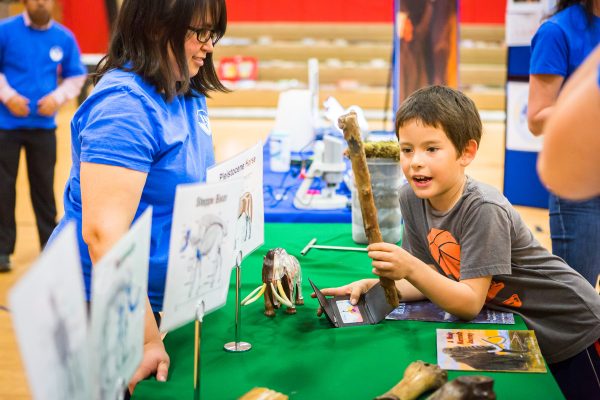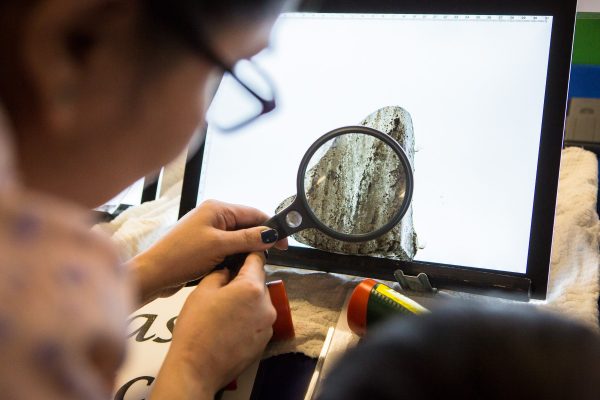Permafrost tunnel highlighted at Oregon museum's exhibit
October 26, 2017
Sue Mitchell
907-474-5823

A walk-through replica of the U.S. Army Corps of Engineers' permafrost research tunnel in Fox, Alaska, will be part of a display opening Nov. 3 at the Oregon Museum of Science and Industry in Portland, Oregon.
The newest addition to OMSI's fun and educational repertoire is "Under the Arctic: Digging into Permafrost." The exhibit views climate change through the lens of a thawing Arctic, using exciting interactive features such as the replica permafrost tunnel, fossil research stations and interactive games.
The exhibit, a collaborative effort between OMSI and the University of Alaska Fairbanks Geophysical Institute, transports visitors to the Arctic using the sights and smells of the nation’s only permafrost research tunnel. Museum-goers can explore real ice age fossils, ancient ice cores and the engineering challenges posed by thawing permafrost.
Professor Matthew Sturm and his Geophysical Institute colleagues, in concert with OMSI staff, developed the 2,000-square-foot exhibit with the help of a grant from the National Science Foundation. It's part of a four-year project called “Hot Times in Cold Places: The Hidden World of Permafrost.” In addition to creating the museum exhibit, the project has taken other exhibits and presentations to 37 villages in Alaska.
The OMSI exhibit opens on Friday, Nov. 3, with a preview for special invited guests. Sturm and his team will join a panel of experts to answer questions from the public.
“Climate change can be hard to wrap your head around. For a lot of people who don’t experience its effects, it feels abstract or distant — like something in the future,” said Allyson Woodard, an exhibit developer with OMSI. “This exhibit is an opportunity to make the impacts of climate change tangible — you can see it, touch it and even smell it.”

Permafrost is soil that has been frozen for at least two years, and it traps an enormous amount of carbon. As it thaws, the carbon is released into the atmosphere as methane and carbon dioxide, which in turn amplify global warming. This exhibit strives to be fun and to educate visitors about permafrost’s fascinating characteristics and its greater implications.
“We’ve thought a lot about the emotional journey in this exhibit. We know that climate change can be scary or confusing, so we’ve taken into consideration how to guide people to a place of hope,” said Nancy Stueber, president and CEO of OMSI. “I hope that in the end, people come away with a sense of empowerment and self-advocacy — the idea that I may not be able to change the world necessarily, but there are small things I can to do to contribute to the greater good.”
The Permafrost Tunnel Research Facility in Fox is maintained by the Cold Regions Research and Engineering Laboratory, an arm of the U.S. Army Corps of Engineers.
OMSI contracted with exhibit sculptor Jonquil LeMaster to construct a 30-foot-long replica of the tunnel. LeMaster, who has created habitats for the San Diego Zoo, came to Alaska and spent a week studying the real tunnel.
“Hopefully this exhibit is powerful enough, beautiful enough, interesting enough, that anyone would look at it and be moved somehow," LeMaster said.
About OMSI
Founded in 1944, the Oregon Museum of Science and Industry is one of the nation’s leading science museums, a world-class tourist attraction and an award-winning educational resource for the kid in each of us. OMSI operates the largest museum-based outdoor science education program in the country and provides traveling and community outreach programs that bring science learning opportunities to schools and community organizations in nearly every county in Oregon. OMSI is located at 1945 SE Water Avenue, Portland, OR 97214. For general information, call 503-797-4000 or visit omsi.edu.
ADDITIONAL CONTACT: John Farmer, OMSI, jfarmer@omsi.edu, 503-797-4517


